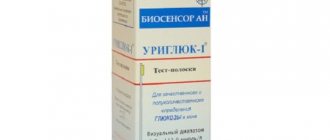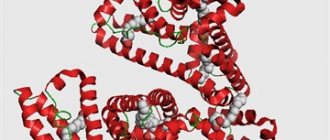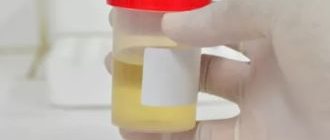A urine test for metanephrine and normetanephrine is a clinical examination of a biological sample for the presence of intermediate breakdown products of adrenaline, norepinephrine and dopamine.
These microelements are formed from the interaction of catecholamine hormones with a specific enzyme and accumulate in the adrenal glands.
Understanding Metanephrine and Normetanephrine
Metanephrine and normetanephrine are part of the catecholamines. When the human body is under physical or emotional stress, hormonal substances are released into the blood.
They perform a number of functions:
- transmit nerve impulses from organs and systems to the brain;
- release glucose and fatty acids in the kidneys;
- participates in the process of dilation of the pupils, alveoli in the bronchi;
- constrict blood vessels, increasing the speed of blood circulation;
- accelerate metabolic processes and the frequency of contractions of the heart muscles.
When catecholamines have completed their task, they enter an inactive phase, break down into metanephrine and normetanephrine, and are excreted from the body through the urinary system.
A healthy person's urine may contain small amounts of metanephrine.
The urine of a healthy person may contain a small amount of metanephrine; this is considered normal. In stressful situations and after them, its concentration increases - it is considered normal. A constant excess of catecholamines in urine indicates the development of pathologies of the endocrine system.
Normal values
Normetanephrine concentrations usually change with age. Reference values (mcg/day): • Birth up to 3 months - 47-156. • 3-6 months - 31-111. • 6-9 months – 42-109. • 9-12 months – 23-103. • 1-2 years - 32-118. • 2-6 years – 50-111. • 6-10 years - 47-176. • 10-16 years old - 53-290. • in 16 years - 105-354.
The normal concentration of free fractions of normetanephrine for adults is 6-115 mg/day. The result is evaluated in comparison with the total level of free and bound molecules. Physiological increases in values occur during exercise, emotional stress, alcohol, caffeine, and nicotine.
The need for analysis
A urine test for metanephrine and normetanephrine confirms and refutes the presence of tumor formations (pheochromocytomas) in adults, neuroblastomas and paragangliomas in children. A therapist, endocrinologist, oncologist, or cardiologist can write out an appointment for analysis.
The basis for analyzing urine for breakdown products of the catecholamine hormone are the following symptoms:
- high blood pressure;
- tachycardia, heart pain;
- severe headaches;
- nausea, vomiting;
- increased sweating;
- dryness of the mucous membranes of the mouth;
- tingling in the arms and legs.
A urine test for metanephrine and normetanephrine confirms and refutes the presence of tumor formations. A
timely detected disease is more quickly treatable than an advanced form. It is unreasonable to ignore the body’s signals to pathological processes in it.
Indications
Analysis of metanephrines in urine has a high diagnostic value. It is quite sensitive - it clearly identifies the disease even at small concentrations and is specific - it allows an accurate diagnosis, while testing for catecholamines is not always advisable, since these substances are destroyed very quickly.
The main indications for determining metanephrines in urine are as follows:
- Diagnosis and observation of catecholamine-secreting tumors: neuroblastoma, ganglioneuroma, pheochromocytoma, paraganglioma, etc.;
- Monitoring the effectiveness of the therapy and predicting the patient’s condition during the rehabilitation period after removal/conservative treatment of the tumor;
- Establishing the causes of hypertensive conditions. If arterial hypertension does not respond well to conservative treatment, then it should be assumed that the pathology is associated with the activity of pheochromocytoma;
- Suspicion of a neuroendocrine disease (based on ultrasound or MRI results);
- Screening of patients at risk (hereditary predisposition).
The results of the analysis are prescribed and interpreted by specialists: oncologist, endocrinologist, general practitioner.
A urine test for metanephrines is carried out for the following symptoms:
- high blood pressure, which is poorly controlled by antihypertensive drugs;
- constantly elevated body temperature without signs of infection in the body;
- rapid heartbeat - tachycardia, arrhythmia;
- headaches, sleep disturbances, dizziness;
- surges in blood glucose in people without diabetes;
- frequent attacks of lightheadedness or fainting;
- nausea, weight loss without dietary restrictions, constant dry mouth;
- disturbances in the functioning of the nervous system (hyperexcitability, nervousness, tearfulness, attacks of fear or panic).
The analysis may be prescribed for suspected pheochromocytoma, neuroblastoma and ganglioneuroma. And also for diagnosing certain forms of hepatitis and other disorders.
The examination is prescribed exclusively by a doctor (general practitioner, oncologist, endocrinologist, cardiologist) to detect cancer developing in the nervous system, as well as a malignant tumor called pheochromocytoma. It is formed in the endocrine glands - the adrenal glands. As this disease progresses, large amounts of a substance called catecholamine are produced, which can be found in the urine. The presence of pheochromocytoma may be indicated by a number of symptoms that give rise to examination:
- high blood pressure;
- elevated temperature;
- headache and dizziness;
- cardiopalmus;
- nausea and feeling of dry mouth;
- increased sweating.
With dysfunction of the adrenal glands, tumors on them or other neuroendocrine neoplasms, the production of catecholamines increases. In other words, the endocrine system releases an excess dose of hormones into the blood, and the purification system cannot cope with the removal, so their concentration in the blood and urine remains consistently high.
- Tachycardia, causeless increase in heart rate, sudden increase in temperature, excessive sweating, wave-like attacks of heat.
- High blood pressure that cannot be treated for a long time, increased intraocular pressure.
- Panic attacks, tremors of the limbs, causeless anxiety and excitement, sudden changes in mood.
- Blood sugar surges, pale extremities, tingling and numbness.
- Detection of changes in adrenal tissue, tumors, cyst-like neoplasms.
- The presence of a diagnosed pheochromacytoma in close relatives.
DETAILS: Bright yellow urine in women, men and children: causes and how to bring the color back to normal
Analysis of metanephrines in urine has a high diagnostic value. It is quite sensitive - it clearly detects the disease even at small concentrations and is specific - it allows you to make an accurate diagnosis, while testing for catecholamines is not always advisable, since these substances are destroyed very quickly.
What does their presence in urine indicate?
Benign and malignant tumors accumulate catecholamines in large quantities. By reacting with the enzyme 3,4-catechol-O-methyltransferase, they are transformed into adrenaline and norepinephrine. Intermediate products of the breakdown of microelements identified in the analyzed portion of urine are an indicator of the development of pathologies.
A dangerous and unpleasant diagnosis with elevated levels of metanerphrines in the urine is a neuroendocrine tumor. To establish its nature, benign or malignant, a urine analysis alone is not enough; a tissue biopsy of the neoplasm will help.
The presence of metanephrines and normetanephrines may signal the development of concomitant diseases in the body that affect the urinary system. These include arterial hypertension, caused by a sharp rise in pressure due to excessive production of adrenal hormones.
This state of the circulatory system negatively affects the functioning of internal organs - heart, kidneys, liver, lungs and others. The risk of stroke and heart attack increases significantly.
Reasons for changes in indicators
It is worth knowing that free metanephrines in the urine, in addition to tumors, are found in hepatitis, myocardial infarction, peptic ulcer in the acute phase, hypothalamic syndrome, and alcohol intoxication.
Drugs that increase catecholamines in urine:
- adelfan;
- diuretics;
- insulin;
- antidepressants;
- paracetamol;
- antibiotics;
- aminophylline.
- adelfan;
- diuretics;
- insulin;
- antidepressants;
- paracetamol;
- antibiotics;
- aminophylline.
Preparing for the test
In order for the results of tests for the detection of metanephrines and normetanephrines to be reliable, it is necessary to prepare for the collection of excrement that is excreted by the kidneys. 2-3 days before collecting a biological sample, it is prohibited to:
- take medications (MAO inhibitors, antivirals, tranquilizers);
- use vasoconstrictor nasal drops (sprays);
- lead an active lifestyle, overexert yourself;
- be nervous.
It is recommended to exclude from the diet: eggs, cheese, bananas, pineapples, baked goods with vanilla, tomatoes, avocados. Refrain from drinking alcohol, coffee, sweet carbonated drinks, tea for 3 days.
Do not take medications before taking the test
If a person smokes, he must wait 3 hours from smoking a cigarette before collecting urine so that nicotine and other impurities do not distort the final result of the research. In addition, nicotine increases blood pressure, which provokes an increase in the level of adrenal hormones in the blood. And this indicator is directly related to the microelements sought in urine.
To collect and store daily analysis, you need to buy a three-liter container and a special preservative, which is added to the excrement to preserve its original composition.
Normal values
Normetanephrine concentrations usually change with age. Reference values (mcg/day): • Birth up to 3 months - 47-156. • 3-6 months - 31-111. • 6-9 months – 42-109. • 9-12 months – 23-103. • 1-2 years - 32-118. • 2-6 years – 50-111. • 6-10 years - 47-176. • 10-16 years old - 53-290. • in 16 years - 105-354. The normal concentration of free fractions of normetanephrine for adults is 6-115 mg/day. The result is evaluated in comparison with the total level of free and bound molecules. Physiological increases in values occur during exercise, emotional stress, alcohol, caffeine, and nicotine.
Collection and delivery of urine
Collecting urine for this study requires detailed instructions. Usually the patient is introduced to all the rules when a referral for analysis is issued.
The urine collection period is exactly one day, for example, from 6.00 today to 6.00 the next day. With each urination, a portion of urine is collected in a plastic container, where a preservative is added. Place the container with excrement in the refrigerator until the next urination. The first and last portions of urine are not taken into account for the analysis; they do not need to be collected.
If a person produces more than 3 liters of urine per day, this indicates abnormalities in the functioning of the kidneys and urinary system.
You need to bring about 100 ml of urine to the laboratory in a plastic container with a tightly closed lid. This quantity is sufficient to carry out such an analysis.
Assessing the results of the analysis and the factors influencing it
If the patient followed all the recommendations regarding diet, lifestyle and activity during the period of preparation for the test, and also carried out the sample collection procedure correctly, then the result will quite accurately indicate the presence of disorders in the functioning of the adrenal glands. However, elevated levels of metanephrines do not always indicate pheochromacytoma. Increasing the values is possible in the following cases:
- Neurochromaffin tumors such as neuroblastoma, paraganglioma and others.
- Chronic stress.
- Heart failure, myocardial infarction, chronic angina.
- Chronic and toxic hepatitis, liver cirrhosis.
- Hypertension in the acute phase or during the manifestation of the disease.
- Peptic ulcer disease during exacerbation.
- Hypothalamic syndrome.
- Alcohol, nicotine or drug addiction in the patient.
- Long-term treatment with certain drugs (mainly used in the treatment of endocrine or neurological diseases).
A decrease in metanephrine content is sometimes characteristic of acute leukemia or degenerative changes in chromaffin tissue. If a patient has deviations in tests from the average normal values, additional diagnostics are indicated.











